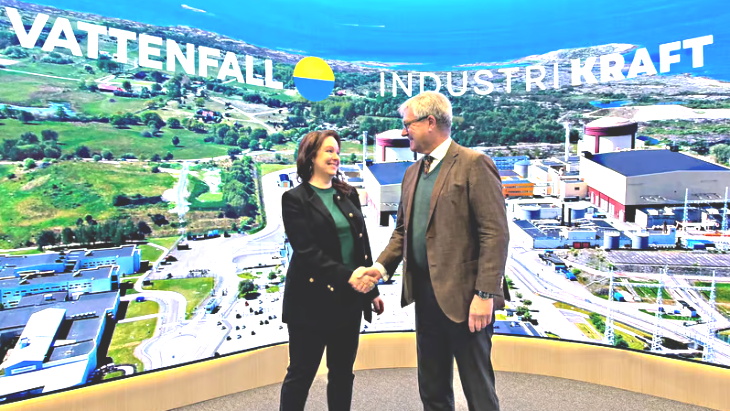Swedish state utility Vattenfall has signed an agreement with the industrial consortium Industrikraft i Sverige AB, which will invest SEK 400 million (around US $42 million) for a 20 % stake in Vattenfall’s project company Videberg Kraft AB. The collaboration represents a pivotal step in Sweden’s nuclear revival, aiming to develop a new generation of small modular reactors (SMRs) at Värö Peninsula near Ringhals nuclear power plant.

(Image: Vattenfall)
The Swedish government’s 2025 policy shift from “100% renewable” to “100% fossil-free electricity” has reignited nuclear prospects. New legislation allows state-backed loans and price guarantees for new builds — up to SEK 220 billion (about US $23 billion) over 12 years. These policy frameworks, combined with growing industrial demand for stable, low-carbon electricity, have created favorable conditions for Vattenfall’s expansion.
At Ringhals, Vattenfall plans to install three to five SMRs with a combined output of approximately 1,500 MW. Technologies under evaluation include Rolls-Royce SMR from the UK and GE Vernova’s BWRX-300 from the US. SMRs offer a modular approach with shorter construction times and enhanced safety, making them well-suited to Europe’s future energy mix that requires flexibility and reliability.
Industrikraft’s participation marks a turning point. The consortium represents Sweden’s heavy industries — steel, chemicals, paper, and mining — all of which depend on large-scale electricity supply and stable pricing. By investing directly in nuclear generation, these companies seek to secure long-term access to fossil-free energy while supporting industrial decarbonisation and competitiveness.
For Sweden’s industrial base, this marks a strategic realignment. Hydropower and imports once dominated its electricity mix, but rising carbon costs under the EU ETS and volatile energy prices have made domestic nuclear power increasingly attractive. Nuclear is once again seen as a pillar of the fossil-free transition — reliable, predictable, and capable of supplying the country’s energy-intensive sectors.
Videberg Kraft AB has entered its feasibility phase. Vattenfall is expected to submit its site assessment and technical proposal by 2026, followed by regulatory and environmental reviews. If approved, construction could start before the end of the decade.
Analysts say the project’s outcome could reshape the Nordic energy landscape. A successful Ringhals expansion would not only strengthen Sweden’s grid resilience but also stimulate domestic supply chains in engineering, equipment, and digital control systems. The initiative could become a model for industrial-nuclear partnerships across Europe.
Challenges remain — public acceptance, regulatory timelines, and economic feasibility are all critical factors. Environmental groups continue to argue that wind and storage investments offer faster returns. Yet for Sweden’s industries, stable baseload power is not a luxury but a necessity. The new nuclear plan represents a pragmatic balance between climate goals and industrial reality.
Sweden now stands at a crossroads of its energy future. The combined momentum of policy, industry capital and technology innovation is reviving an energy option that had been dormant for decades. The partnership between Vattenfall and Industrikraft is therefore not just a business venture — it is a strategic statement about how Sweden intends to power its next industrial era.